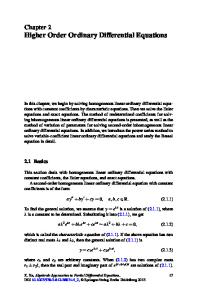First-Order Ordinary Differential Equations
In this chapter, we start with first-order linear ordinary differential equations, and then discuss first-order separable equations, homogeneous equations, and exact equations. Next we present the methods of solving more special first-order ordinary diffe
- PDF / 3,468,662 Bytes
- 407 Pages / 441 x 666 pts Page_size
- 24 Downloads / 439 Views
Algebraic Approaches to Partial Differential Equations
Algebraic Approaches to Partial Differential Equations
Xiaoping Xu
Algebraic Approaches to Partial Differential Equations
Xiaoping Xu Institute of Mathematics Academy of Mathematics and System Science Beijing, People’s Republic of China
ISBN 978-3-642-36873-8 ISBN 978-3-642-36874-5 (eBook) DOI 10.1007/978-3-642-36874-5 Springer Heidelberg New York Dordrecht London Library of Congress Control Number: 2013937319 Mathematics Subject Classification: 35C05, 35C15, 35Q35, 35Q55, 35Q60, 76D05, 75D10 © Springer-Verlag Berlin Heidelberg 2013 This work is subject to copyright. All rights are reserved by the Publisher, whether the whole or part of the material is concerned, specifically the rights of translation, reprinting, reuse of illustrations, recitation, broadcasting, reproduction on microfilms or in any other physical way, and transmission or information storage and retrieval, electronic adaptation, computer software, or by similar or dissimilar methodology now known or hereafter developed. Exempted from this legal reservation are brief excerpts in connection with reviews or scholarly analysis or material supplied specifically for the purpose of being entered and executed on a computer system, for exclusive use by the purchaser of the work. Duplication of this publication or parts thereof is permitted only under the provisions of the Copyright Law of the Publisher’s location, in its current version, and permission for use must always be obtained from Springer. Permissions for use may be obtained through RightsLink at the Copyright Clearance Center. Violations are liable to prosecution under the respective Copyright Law. The use of general descriptive names, registered names, trademarks, service marks, etc. in this publication does not imply, even in the absence of a specific statement, that such names are exempt from the relevant protective laws and regulations and therefore free for general use. While the advice and information in this book are believed to be true and accurate at the date of publication, neither the authors nor the editors nor the publisher can accept any legal responsibility for any errors or omissions that may be made. The publisher makes no warranty, express or implied, with respect to the material contained herein. Printed on acid-free paper Springer is part of Springer Science+Business Media (www.springer.com)
Dedicated to my wife, Jing Jing.
Preface
Partial differential equations are fundamental tools in mathematics, science, and engineering. For instance, electrodynamics is governed by the Maxwell equations, the two-dimensional cubic nonlinear Schrödinger equation is used to describe the propagation of an intense laser beam through a medium with Kerr nonlinearity, and the Navier–Stokes equations are the fundamental equations in fluid dynamics. There are three major ways of studying partial differential equations. The analytic way is to study the existence and uniqueness of certain solutions of partial differential equations and
Data Loading...











